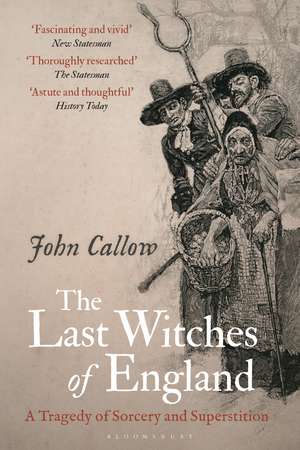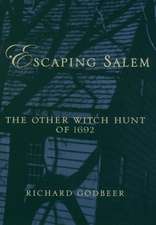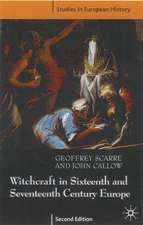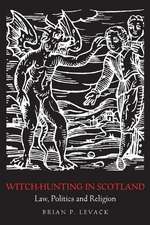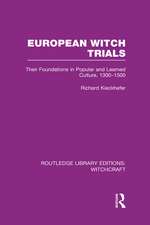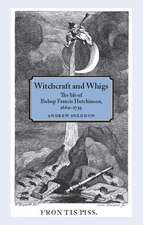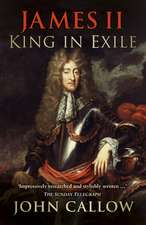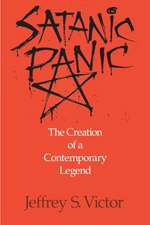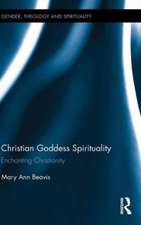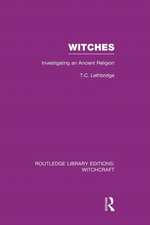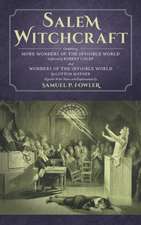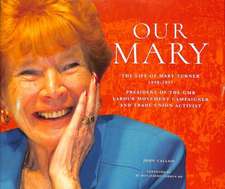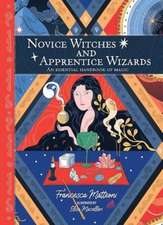The Last Witches of England: A Tragedy of Sorcery and Superstition
Autor John Callowen Limba Engleză Paperback – 6 sep 2023
| Toate formatele și edițiile | Preț | Express |
|---|---|---|
| Paperback (1) | 68.86 lei 3-5 săpt. | +60.46 lei 6-12 zile |
| Bloomsbury Publishing – 6 sep 2023 | 68.86 lei 3-5 săpt. | +60.46 lei 6-12 zile |
| Hardback (1) | 155.79 lei 3-5 săpt. | +118.66 lei 6-12 zile |
| Bloomsbury Publishing – 6 oct 2021 | 155.79 lei 3-5 săpt. | +118.66 lei 6-12 zile |
Preț: 68.86 lei
Preț vechi: 105.01 lei
-34% Nou
Puncte Express: 103
Preț estimativ în valută:
13.18€ • 14.09$ • 10.99£
13.18€ • 14.09$ • 10.99£
Carte disponibilă
Livrare economică 28 martie-11 aprilie
Livrare express 13-19 martie pentru 70.45 lei
Preluare comenzi: 021 569.72.76
Specificații
ISBN-13: 9781350387126
ISBN-10: 1350387126
Pagini: 352
Dimensiuni: 156 x 234 x 25 mm
Greutate: 0.59 kg
Editura: Bloomsbury Publishing
Colecția Bloomsbury Academic
Locul publicării:London, United Kingdom
ISBN-10: 1350387126
Pagini: 352
Dimensiuni: 156 x 234 x 25 mm
Greutate: 0.59 kg
Editura: Bloomsbury Publishing
Colecția Bloomsbury Academic
Locul publicării:London, United Kingdom
Caracteristici
Uncovers a forgotten female history and reveals the changing attitudes towards women and witchcraft over time
Notă biografică
John Callow is an Honorary Research Fellow at the University of Suffolk, UK, who has written widely on early modern witchcraft, politics and popular culture. He is the author of The Making of King James II (2000) and Embracing the Darkness (2005, I.B. Tauris). He has appeared on the BBC Radio 4 documentary It Must be Witchcraft, and the series on the Salem Witches on the Discovery Channel.
Cuprins
IllustrationsAcknowledgementsA Note on Dating & TerminologyPrologue: The Magpie at the WindowChapter One: Fortune My FoeChapter Two: England's Golden BayChapter Three: An Underground ReligionChapter Four: The Cat, the Pig and the PoppetChapter Five: The Stolen Apple & a Farthing's Worth of TobaccoChapter Six: A Fine Gentleman Dressed All in BlackChapter Seven: The Discourse of the Sleepy ChimneyChapter Eight: The Politics of DeathChapter Nine: At the House of the White WitchChapter Ten: Where are the Witches? The Crafting of Memory and SurvivalEndnotesBibliography
Recenzii
Callow's intriguing book is both a case study of the Bideford witch trail and an examination of how superstition prevailed in a time of increasing rationality. Callow's fascinating and vivid unpicking of the English Salem is also an account of the birth pangs of the modern age.
Callow examines in detail the surviving evidence of the Bideford case, while also imaginatively reconstructing events to create a convincing picture of how superstition and belief in sorcery lay just beneath the surface of a mercantile society struggling to be born.
One 17th-century pamphlet about the Bideford trial promised "many Wonderful Things, worth your Reading"; a line that could justifiably be slapped across the cover of [The Last Witches of England].
A retelling of a 17th-century witchcraft trial that never loses sight of the women at its heart, nor the social and economic factors that contributed to their plight. There is no plain explanation for the witchcraft accusations of 1682, but then acts of evil never have a simple origin. The Last Witches of England faces that fact and marshals an intriguing story around new research on the case.
Carrow meticulously explores the haunting tale of the Bideford witches.
An elegantly presented, well illustrated and readable book on how class conflict played out through witch hunting. A timely warning against persecution and intolerance.
In The Last Witches of England John Callow painstakingly reconstructs the lines of three beggar women accused of witchcraft in Bideford, Devon in 1632 by trawling administrate records, parish registers and dole lists. It is a remarkable piece of scholarship.astute and thoughtful.
Vividly told, detailed and extremely moving.
The Last Witches of England is an important work of social history that presents valuable insights into the workings of life, death, and belief in a cosmopolitan 17th-century town.
A well-researched and even-handed account of this landmark case, giving pen portraits of all the major players, and providing a comprehensive picture of life in seventeenth-century Britain.
[Written] with flair and colour. Excellent local studies such as [this] bring[s] us closer to understanding the reality of witchcraft beliefs and accusations in the early modern English world than we have ever seen before.
I rarely feel deeply moved by academic publications but John Callow's exploration of the 'Bideford Witches' had a profound effect on me. Callow's work invites the reader to bear witness to the persecution of the poor and the marginalised. Callow's work adds considerable weight to a strong moral argument.
This riveting read is important albeit uncomfortable. In this book, Callow has allowed readers to look at their shared past unflinchingly so that we may go into a less tragic future.
A marvellous overview of not only the fate of three women but also of Bideford which was an important port in the 17th Century... with an in depth study of the social and political conditions surrounding the fate of 'The last witches' is extremely valuable for those who are interested in the historical background to Wicca, but also for understanding the recent interest in Witchcraft as a political tool.
The Last Witches of England: A Tragedy of Sorcery and Superstition offers a thoroughly engaging account of the lives and afterlives of Temperance Lloyd, Susanna Edwards, and Mary Trembles, three women who were executed for witchcraft in 1682. It is a well-told narrative that will be of interest to scholars of witchcraft, as well as those working more broadly in early modern British social history
[Callow] brings to the Bideford episode a nuanced sense of how witches' supposed powers were understood and experienced at different levels of early modern society.
The Bideford witches' story is an essential piece in England's witchcraft history. Callow has researched it properly and deeply for the first time, and his astonishing discoveries shed new light on this tragic and bizarre story. He draws the reader into the story, retelling it with vibrant characterisation. We come away with a thoughtful understanding of what it meant to be deemed a witch, tried as a witch, and to die as a witch.
I read the book with considerable interest and enjoyment - others have written on the Bideford witches, but not in this sort of depth. John Callow has been remarkably successful in reconstructing the story of the three 'Bideford Witches' executed in 1682. He maintains an imaginative and accessible narrative grounded in the relevant documentation and the relevant historical context, which will immerse the modern reader in the tragedies and complexities of the early modern witch hunts.
This is a stirring and multilayered book. At its heart is a very sad story, but one that needs to be heard. The cautionary tale Callow spins here is not the war between superstition and reason, but in the ways in which we have historically vilified and marginalized those in poverty, especially women, and the lengths we go to in silencing their voices.
With 17th Century culture wars, conspiracy theories and non-science, it wasn't just the people who spread deadly superstition. Political, religious, media, scientific and even legal establishments literally demonised vulnerable women.John Callow's meticulous and gripping history of the Bideford Witches is unputdownable.
Callow examines in detail the surviving evidence of the Bideford case, while also imaginatively reconstructing events to create a convincing picture of how superstition and belief in sorcery lay just beneath the surface of a mercantile society struggling to be born.
One 17th-century pamphlet about the Bideford trial promised "many Wonderful Things, worth your Reading"; a line that could justifiably be slapped across the cover of [The Last Witches of England].
A retelling of a 17th-century witchcraft trial that never loses sight of the women at its heart, nor the social and economic factors that contributed to their plight. There is no plain explanation for the witchcraft accusations of 1682, but then acts of evil never have a simple origin. The Last Witches of England faces that fact and marshals an intriguing story around new research on the case.
Carrow meticulously explores the haunting tale of the Bideford witches.
An elegantly presented, well illustrated and readable book on how class conflict played out through witch hunting. A timely warning against persecution and intolerance.
In The Last Witches of England John Callow painstakingly reconstructs the lines of three beggar women accused of witchcraft in Bideford, Devon in 1632 by trawling administrate records, parish registers and dole lists. It is a remarkable piece of scholarship.astute and thoughtful.
Vividly told, detailed and extremely moving.
The Last Witches of England is an important work of social history that presents valuable insights into the workings of life, death, and belief in a cosmopolitan 17th-century town.
A well-researched and even-handed account of this landmark case, giving pen portraits of all the major players, and providing a comprehensive picture of life in seventeenth-century Britain.
[Written] with flair and colour. Excellent local studies such as [this] bring[s] us closer to understanding the reality of witchcraft beliefs and accusations in the early modern English world than we have ever seen before.
I rarely feel deeply moved by academic publications but John Callow's exploration of the 'Bideford Witches' had a profound effect on me. Callow's work invites the reader to bear witness to the persecution of the poor and the marginalised. Callow's work adds considerable weight to a strong moral argument.
This riveting read is important albeit uncomfortable. In this book, Callow has allowed readers to look at their shared past unflinchingly so that we may go into a less tragic future.
A marvellous overview of not only the fate of three women but also of Bideford which was an important port in the 17th Century... with an in depth study of the social and political conditions surrounding the fate of 'The last witches' is extremely valuable for those who are interested in the historical background to Wicca, but also for understanding the recent interest in Witchcraft as a political tool.
The Last Witches of England: A Tragedy of Sorcery and Superstition offers a thoroughly engaging account of the lives and afterlives of Temperance Lloyd, Susanna Edwards, and Mary Trembles, three women who were executed for witchcraft in 1682. It is a well-told narrative that will be of interest to scholars of witchcraft, as well as those working more broadly in early modern British social history
[Callow] brings to the Bideford episode a nuanced sense of how witches' supposed powers were understood and experienced at different levels of early modern society.
The Bideford witches' story is an essential piece in England's witchcraft history. Callow has researched it properly and deeply for the first time, and his astonishing discoveries shed new light on this tragic and bizarre story. He draws the reader into the story, retelling it with vibrant characterisation. We come away with a thoughtful understanding of what it meant to be deemed a witch, tried as a witch, and to die as a witch.
I read the book with considerable interest and enjoyment - others have written on the Bideford witches, but not in this sort of depth. John Callow has been remarkably successful in reconstructing the story of the three 'Bideford Witches' executed in 1682. He maintains an imaginative and accessible narrative grounded in the relevant documentation and the relevant historical context, which will immerse the modern reader in the tragedies and complexities of the early modern witch hunts.
This is a stirring and multilayered book. At its heart is a very sad story, but one that needs to be heard. The cautionary tale Callow spins here is not the war between superstition and reason, but in the ways in which we have historically vilified and marginalized those in poverty, especially women, and the lengths we go to in silencing their voices.
With 17th Century culture wars, conspiracy theories and non-science, it wasn't just the people who spread deadly superstition. Political, religious, media, scientific and even legal establishments literally demonised vulnerable women.John Callow's meticulous and gripping history of the Bideford Witches is unputdownable.
